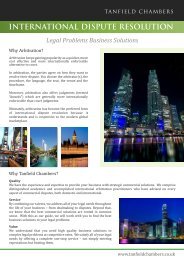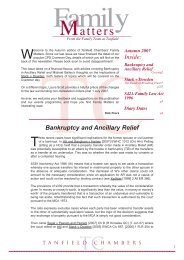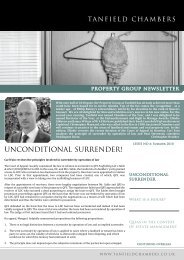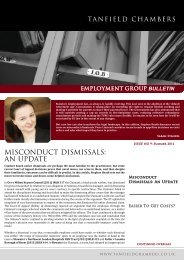Link to newsletter - Tanfield Chambers
Link to newsletter - Tanfield Chambers
Link to newsletter - Tanfield Chambers
Create successful ePaper yourself
Turn your PDF publications into a flip-book with our unique Google optimized e-Paper software.
TA N F I E L D C H A M B E R Sfamily group <strong>newsletter</strong>A warm welcome back <strong>to</strong> all our readers and delighted <strong>to</strong> see so many of you at the recent CPD‘Crammer Days’. We hope that you found the seminars both interesting and useful and look forward<strong>to</strong> bringing you another update on family law next year. It was extremely kind of theSupreme Court <strong>to</strong> hand down their judgment in Radmacher just in time for our first ‘CrammerDay’ and for Charlotte Jewell <strong>to</strong> be able <strong>to</strong> enlighten us all as <strong>to</strong> its content and potential impact.With that in mind, and especially for those of you who were not able <strong>to</strong> attend, our first Articledeals with the Radmacher Judgment. Enjoy!Dick PearsISSUE NO 8: Winter 2010Radmacher –v- Granatino: nuptialagreements binding, so long as they are fairThe long awaited judgment in the much talked about appeal in the case of Radmacher(formerly Granatino) (Respondent) –v- Granatino (Appellant) [2010] UKSC 42 wasfinally handed down on Wednesday 20 Oc<strong>to</strong>ber 2010. The Supreme Court (by amajority of 8 <strong>to</strong> 1) dismissed the appeal against the decision of the Court of Appeal.Interestingly, the dissenting judgment was given by Lady Hale, the member of thecourt with the most experience of family cases in the English courts.The central issue dealt with in the appeal concerns the principles <strong>to</strong> be applied when a court,in considering the financial arrangements following the breakdown of a marriage, has <strong>to</strong>decide what weight should be given <strong>to</strong> an agreement between a husband and wife madebefore the marriage.The essential point of principle, now established by the Supreme Court in Radmacher, asneatly summarised by the majority at paragraph 75, is this:"The court should give effect <strong>to</strong> a nuptial agreement that is freely entered in<strong>to</strong> by eachparty with a full appreciation of its implications unless in the circumstancesprevailing it would not be fair <strong>to</strong> hold the parties <strong>to</strong> their agreement."The court stressed that whilst in the right case a nuptial agreement can have decisive orcompelling weight (para 83), a nuptial agreement cannot oust the jurisdiction of the court(para 2) and cannot be allowed <strong>to</strong> prejudice the reasonable requirements of any child of thefamily (para 77). However, the court made clear that respect should be given <strong>to</strong> individualau<strong>to</strong>nomy (para 78) and the reasonable desire <strong>to</strong> make provision for existing propertyWITH THIS PRE-NUP,I THEE WEDA REVIEW OF THE LAWON ICO'S - HAVE WECOME FULL CIRCLE?IS IT POSSIBLE ORDESIRABLE TO DEFINE'SIGNIFICANT HARM'continued overleafW W W. T A N F I E L D C H A M B E R S . C O . U K
Estelle LearEstelle’s practice covers all areas of familylaw including children (both public andprivate law), ancillary relief and Schedule 1applications. Estelle is particularlyinterested in cases with an internationalelement. Prior <strong>to</strong> joining the Bar, Estellehad extensive exposure <strong>to</strong> care work, havingworked for two local authorities and spent three years working as alegal costs negotia<strong>to</strong>r. Outside work, Estelle is a keen pho<strong>to</strong>grapherand can also regularly be found walking her beloved dog on theHeath!owned by one or the other party, or property that one or otheranticipates receiving from a third party (para 79). A distinctionshould no longer be made between agreements made pre orpost marriage (para 63), a distinction that had been made bythe Privy Council in the case of MacLeod –v- MacLeod [2008]UKPC 64.In order for a nuptial agreement <strong>to</strong> have decisive or compellingweight, each party should have all of the information that ismaterial <strong>to</strong> his or her decision and each party should intend thatthe agreement should govern the financial consequences of themarriage coming <strong>to</strong> an end (para 69). The court will continue <strong>to</strong>pay close attention <strong>to</strong> the circumstances in which theagreement was reached, so as <strong>to</strong> ensure that no unfairadvantage was taken of any potentially weaker party (usually attimes of high emotion, whether pre or post marriage, whereinequalities of bargaining power may well exist).The question of weight <strong>to</strong> be attached will continue <strong>to</strong> beconsidered as part of 'all the circumstances of the case' or as anexample of conduct that it would be inequitable for the court <strong>to</strong>disregard within the meaning of section 25 Matrimonial CausesAct 1973. It would therefore appear that whilst the startingpoint or onus, as Lord Mance puts it, is that nuptial agreements,freely entered in<strong>to</strong> with a full appreciation of its implicationsshould be upheld, the ultimate question remains as <strong>to</strong> what isfair and thus, the starting point or onus is unlikely <strong>to</strong> matteronce all the facts are before the court (para 129). This may bedesirable if fairness is <strong>to</strong> be achieved where unforeseen (andperhaps unforeseeable) changes have occurred since theparties entered in<strong>to</strong> the nuptial agreement. It is suggested thatthe longer the marriage, the more likely it is that the partiesshould not be held <strong>to</strong> their agreement (para 80).Whilst Radmacher does not import a change in the law per se,it is the clearest indication yet that, in the right circumstances, anuptial agreement will be respected and upheld by the courts.Be that as it may, there is no doubt that the law of maritalagreements is messy and uncertain and that any root andbranch reform depends on Parliamentary intervention. TheLaw Commission continues <strong>to</strong> consider whether legal reform isrequired (a consultation paper is due <strong>to</strong> be published on thesubject shortly). Unless and until systematic review and reformtakes place, such cases will continue <strong>to</strong> be considered by thecourts on a case by case basis, with reference <strong>to</strong> the section 25criteria.Estelle Learour authorsTCINTERIM CARE ORDERS:-There is always a frisson of excitement when two members ofchambers appear in opposition at the Court of Appeal. This wasclearly evident when Robin Powell and I clashed swords this latesummer. I shall leave it <strong>to</strong> readers <strong>to</strong> discover who “won” the case.This is of course not an analogy suitable for cases involving children.But barristers will be barristers.On 29 July 2010 the Court of Appeal handed down judgment in thecase of Re GR (Children) & others [2010] EWCA Civ 871. The LocalAuthority appealed against the refusal of a Recorder <strong>to</strong> make aninterim care order in respect of two of four children where theRecorder had granted interim care orders in relation <strong>to</strong> the olderchildren. The judgment provides those interested in the day-<strong>to</strong>-daytwists and turns of contested interim care hearings with a usefulreview of where we are now following various recent interpretationsby the courts of the hurdles <strong>to</strong> cross at these hearings.Of course interim care cases must be approached in two stages.Firstly, one looks at what is often called the “threshold” for an interimcare order. One needs <strong>to</strong> apply sections 31 and 38, as those readingthis will be aware. If the court is satisfied as required by s 38(2), itmust then go on <strong>to</strong> consider, as a discrete issue, whether or not <strong>to</strong>grant an interim care order. As in all these cases, this is a questionwith respect <strong>to</strong> the upbringing of the child, so, in accordance with s 1Children Act 1989, the child's welfare is the court's paramountconsideration. We also bear in mind the delay principle and thewelfare check list.Where Re GR (Children) became interesting was the review of theCourt of Appeal of the present state of the authorities in relation <strong>to</strong>interim care orders which serve as a guide as <strong>to</strong> how <strong>to</strong> approach thissecond stage of the court's determination, the purpose of which is, ofcourse, <strong>to</strong> establish a holding position pending a full hearing. Theresult of an interim hearing can have a significant bearing on themanagement of a case and practitioners need <strong>to</strong> have their finger onthe pulse at these hearings.In Re H (a child)(interim care order) [2002] EWCA Civ 1932,Thorpe LJ said:"38. … Above all it seems <strong>to</strong> me important <strong>to</strong> recognise the purposeand the bounds of an interim hearing. There can be no doubt that a fulland profound trial of the local authority's concerns is absolutelyessential. But the interim hearing could not be allowed <strong>to</strong> usurp orsubstitute for that trial. It had <strong>to</strong> be properly confined <strong>to</strong> control theimmediate interim before the court could find room for the essentialtrial.W W W. TA N F I E L D C H A M B E R S . C O . U K
Sarah DinesSarah Dines was called <strong>to</strong> the Bar in 1988 andis one of the most senior female barristers inchambers. She practises primarily in familylaw with an equal split of private and publiclyfunded work. She has taken various highprofile cases <strong>to</strong> the Court of Appeal. Sarah hassignificant experience of big money ancillaryrelief proceedings as well as the more standard financial cases. Shehas dealt with care cases involving serious injuries and has alsoundertaken significant sexual abuse hearings in the High Court. Shelives in rural Essex with her husband and four children.Timothy ShuttleworthCalled in 1971, Timothy Shuttleworth hashad a varied practice at the Bar over thelast 38 years covering criminal cases(prosecuting and defending) and mostaspects of civil claims and family work. In1985, he began <strong>to</strong> practice exclusively infamily cases, personal injury claims and some employment workbefore in the last 19 years concentrating solely on family litigation,both children and money. Tim has helped train NSPCC officers andlectured widely on family-related themes, as well as on <strong>to</strong>pics suchas the Human Rights Act (including training Local Authorityprofessionals on the Act), elder abuse and the Mental Capacity Act2005. Last year he began <strong>to</strong> lecture on Richard III (both his<strong>to</strong>ricalfigure and the play) and he hopes <strong>to</strong> make many more defences ofthis much maligned monarch.WHERE ARE WE NOW?39. …..In my judgment, the arts 6 and 8 rights of the parents requiredthe judge <strong>to</strong> abstain from premature determination of their case forthe future beyond the final fixture, unless the welfare of the childdemanded it. In effect, since removal from these lifelong parents <strong>to</strong>foster parents would be deeply traumatic for the child, and of courseopen <strong>to</strong> further upset should the parents' case ultimately succeed, thatseparation was only <strong>to</strong> be contemplated if B's safety demandedimmediate separation."This case was the genesis of the need for the child’s safety <strong>to</strong> “demandimmediate separation”, which appeared <strong>to</strong> be a stronger test thanpreviously applied and is frequently quoted up and down the length ofthe country.In Re M (ICO: Removal) [2005] EWCA Civ 1594, Thorpe LJ (onceagain) referred, in the final paragraph of his judgment, <strong>to</strong> "the veryhigh standards that must be established <strong>to</strong> justify the continuingremoval of a child from home" as well as <strong>to</strong> the need <strong>to</strong> weigh in thebalance the potential risk <strong>to</strong> the child of extended separation fromtheir parents.In Re K and H [2006] EWCA Civ 1898, Thorpe LJ continued in thisvein:"16. Decisions in this court emphasised that at an interim stage theremoval of children from their parents is not <strong>to</strong> be sanctioned unlessthe child's safety requires interim protection."The Court considered the treatment of the law by Ryder J in thefollowing case:In Re L-A [2009] EWCA Civ 822, influenced by the decision of RyderJ in Re L (Care Proceedings: Removal of Child) [2008] 1 FLR 575which he considered <strong>to</strong> have altered the law, the trial judge had notmade an interim care order when it appears he might otherwise havebeen inclined <strong>to</strong> do so. The reference in Ryder J's judgment in Re Lwhich had influenced him was <strong>to</strong> "an imminent risk of really seriousharm i.e. whether the risk <strong>to</strong> ML's safety demands immediateseparation". On appeal, it was common ground that Ryder J had notintended <strong>to</strong> alter the approach set out in the three Court of Appealcases referred <strong>to</strong> already. Thorpe LJ <strong>to</strong>ok the opportunity <strong>to</strong> restatethe principles established by those authorities. From paragraphs 38and 39 of Re H, he extracted two propositions:"that the decision taken by the court on an interim care orderapplication must necessarily be limited <strong>to</strong> issues that cannot await thefixture and must not extend <strong>to</strong> issues that are being prepared fordetermination at that fixture" and"that separation is only <strong>to</strong> be ordered if the child's safety demandsimmediate separation."The Court of Appeal stated in the present case Re GR that theimportant point from Re M was the very high standard which a localauthority must meet in seeking <strong>to</strong> justify the continuing removal of achild from home.It was therefore clear, following Re L-A, that it was <strong>to</strong> the traditionalformulation in the Court of Appeal authorities that courts andpractitioners should turn, not <strong>to</strong> Ryder J's phraseology. This came as arelief <strong>to</strong> those at the Bar who felt that Ryder had just gone <strong>to</strong>o far.The most recent case <strong>to</strong> which the Court referred in the present casewas Re B and KB [2009] EWCA 1254 in which the appeal wasagainst the dismissal of the local authority's application for an interimcare order. The trial judge had given himself what was described as an"immaculate self-direction" in these terms:"whether the continued removal of KB from the care of her parents isproportionate <strong>to</strong> the risk of harm <strong>to</strong> which she will be exposed if sheis allowed <strong>to</strong> return <strong>to</strong> her parents' care".Lady Justice Black stated in the present case that it may do no harm <strong>to</strong>invite particular attention <strong>to</strong> Wall LJ's definition of "safety" in thispassage in Re B and KB. The concept of a child's safety, as referred <strong>to</strong>in the authorities, is not confined <strong>to</strong> his or her physical safety andincludes also his or her emotional safety or, as Wall LJ put it,psychological welfare.In conclusion, the Court of Appeal are back <strong>to</strong> the traditionalinterpretation of the relevant statute in that ICOs should not be madeunless the child’s welfare demands immediate removal from theparent/s care. It appears we have come full circle over the last 10years.Sarah DinesW W W. TA N F I E L D C H A M B E R S . C O . U K
THE DANGERS OF BEING PRECISEIs it necessary or even wise <strong>to</strong> provide a definition of what amounts <strong>to</strong>“significant harm” in Section 31 (2) of the Children Act 1989?This question arises because once again the press are on the warpathabout the care system suggesting that it is incapable of discharging thetask of protecting children. In a recent edi<strong>to</strong>rial headed “We must protectchildren from their protec<strong>to</strong>rs”, The Sunday Telegraph opined:“…the most serious problem with the child protection system is morefundamental than a lack of money. It is that neither social workers nor thecourts understand exactly what they are supposed <strong>to</strong> be doing. The lawsays that intervention is justified <strong>to</strong> prevent “significant harm” <strong>to</strong> the“interests of the child”. The Government has issued hundreds of pages of“guidance for practitioners”- but not one of them provides a precisedefinition of what “significant harm” means…a meaningful definition of“significant harm” should be inserted in<strong>to</strong> child protection legislation andin<strong>to</strong> the guidance that goes with it. That would at least give those whowork in the system a clear idea of what they are supposed <strong>to</strong> be doing”.As it happens, the Court of Appeal has recently given some guidance on themeaning of “significant harm” in Re MA (Care Threshold) [2010] 1 FLR431. The case is important because, as Ward LJ states in his judgment, thisappeal provided the court with its first opportunity <strong>to</strong> consider thedividing line between “harm” and “significant harm”.My dictionary adds “weighty, telling, substantial”.Let the wordsmiths at telegraph.co.uk provide a better and moremeaningful definition if they can, taking in<strong>to</strong> account the need <strong>to</strong> showsome degree of flexibility affecting the courts’ approach <strong>to</strong> the“momen<strong>to</strong>us step” of possibly removing a child permanently fromhis/her parents in a free and democratic society that values diversityand individuality.Timothy ShuttleworthNewsDIARY DATES<strong>Tanfield</strong> Family are delighted <strong>to</strong> announce that, once again,Gerald Wilson and Laura Scott have been listed in The Legal 500.This year we had two very successful CPD Crammer Days; due <strong>to</strong>popular demand, one of those days was entirely dedicated <strong>to</strong>TOLATA applications. If you have any suggestions for futureseminars or specific areas of family law that you would like us <strong>to</strong>consider covering, please contact us as soon as you can. We lookforward <strong>to</strong> hearing from you!With Christmas looming <strong>Tanfield</strong> Family wishes <strong>to</strong> extend ourthanks <strong>to</strong> you for a very busy and productive year and lookforward <strong>to</strong> working alongside you in the New Year.Did the court make a good fist of answering the question? Probably notwith the exactitude that the journalists at the Sunday Telegraph wouldwish!Ward LJ approached a definition of significant harm at page 451,paragraph 54 of his judgment by stating: “Given the underlyingphilosophy of the Act, the harm must…be significant enough <strong>to</strong> justify theintervention of the State and disturb the au<strong>to</strong>nomy of the parents <strong>to</strong> bringup their children by themselves in the way they choose. It must besignificant enough <strong>to</strong> enable the court <strong>to</strong> make a care order or asupervision order if the welfare of the child demands it…there must be a“relevant and sufficient” reason for crossing the threshold”.So far (some may argue) so loose. But can a better definition be advanced?After all, as Hedley J stated at first instance in Re L (Care: ThresholdCriteria) [2007] 1 FLR 2050 at paragraph 51:“It would be unwise <strong>to</strong> a degree <strong>to</strong> attempt an all embracing definition ofsignificant harm. One never ceases <strong>to</strong> be surprised at the extent ofcomplication and difficulty that human beings manage <strong>to</strong> introduce in<strong>to</strong>family life. Significant harm is fact specific and must retain the breadth ofmeaning that human fallibility may require of it…”There is also the problem highlighted by Munby J in Re K: A LocalAuthority v N and others [2007] 1 FLR 399 where the learned judgestated at paragraph 26 of his judgment:“The task of the court considering threshold for the purposes of section 31of the 1989 Act may be <strong>to</strong> evaluate parental performance by reference <strong>to</strong>the objective standard of the hypothetical “reasonable” parent, but thisdoes not mean that the court can simply ignore the underlying cultural,social or religious realities. On the contrary, the court must always besensitive <strong>to</strong> the cultural, social and religious circumstances of theparticular child and family. And the court should, I think, be slow <strong>to</strong> findthat parents only recently or comparatively recently arrived from aforeign country – particularly from a country where standards andexpectations may be more or less different, sometimes very differentindeed, from those with which we are familiar – have fallen short of anacceptable standard of parenting if in truth they have done nothing wrongby the standards of their own community…”.The answer may be that we can do no better than consult the dictionaryfor a definition as Miss Jill Black (now Black LJ) did as counsel inHumberside County Council v B [1993] 1 FLR 257. Counsel relied onthe same dictionary definition of “significant harm” as was offered over 20years ago in the Guidance originally issued <strong>to</strong> explain the Act of 1989. TheGuidance states:“It is additionally necessary <strong>to</strong> show that the ill-treatment is significant,which given its dictionary definition means considerable, noteworthy orimportant”.For further information or <strong>to</strong> instruct a barrister, please contactRichard Pres<strong>to</strong>n, Family Clerk or Kevin Moore, Senior Clerk, onT: +44 (0) 20 7421 5300 or E: clerks@tanfieldchambers.co.ukTANFIELD FAMILY MEMBERS:Gavin Merrylees (1964) Gerald Wilson (1989)Timothy Shuttleworth (1971) Catriona MacLaren (1993)Philip Conrath (1972) Robin Powell (1993)D A Pears (1975)Charlotte Jewell (1999)Kerstin Boyd (1979)Laura Scott (2001)William Holland (1982) Olivia Murphy (2001)Sebastian Reid (1982) Mandy Short (2003)David Sharp (1986)Darren Watts (2005)Michael Bailey (1986) Amanda Jepson (2005)John Buck (1987)Estelle Lear (2006)Sarah Dines (1988)Gwyn Evans (2007)<strong>Tanfield</strong> <strong>Chambers</strong>’ dedicated conference facilities are readily accessibleby the mobility-impaired. Please contact the clerks <strong>to</strong> agree fees inadvance, whether on a fixed or hourly rate. Feedback on our service iswelcomed and should be directed <strong>to</strong> the Senior Clerk, Kevin Moore. Acopy of <strong>Chambers</strong> Complaints’ Procedure is available on our website oron request.To contact us: T: +44 (0) 20 7421 5300, F: +44 (0) 20 7421 5333, DX: 46 London Chancery Lane, E: clerks@tanfieldchambers.co.ukAddress: <strong>Tanfield</strong> <strong>Chambers</strong>, 2-5 Warwick Court, London, WC1R 5DJ


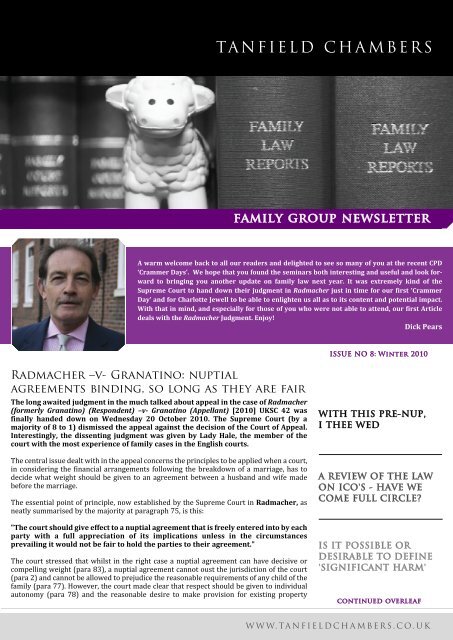
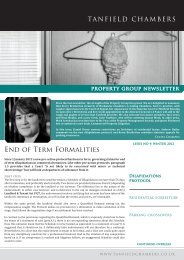

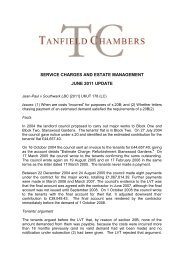
![Re Clarise Properties Ltd [2012] UKUT 4 (LC) - Tanfield Chambers](https://img.yumpu.com/36301708/1/190x245/re-clarise-properties-ltd-2012-ukut-4-lc-tanfield-chambers.jpg?quality=85)



